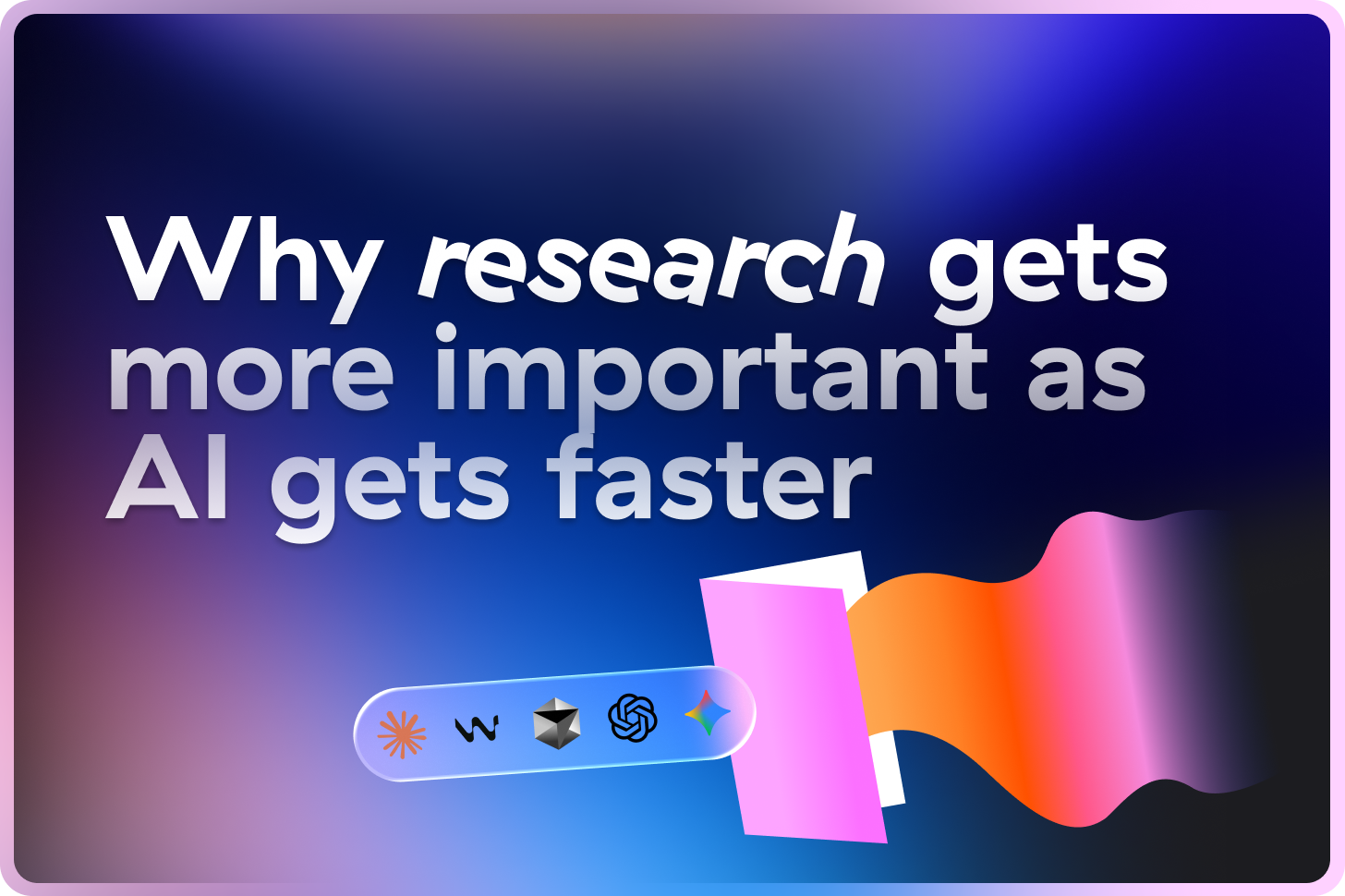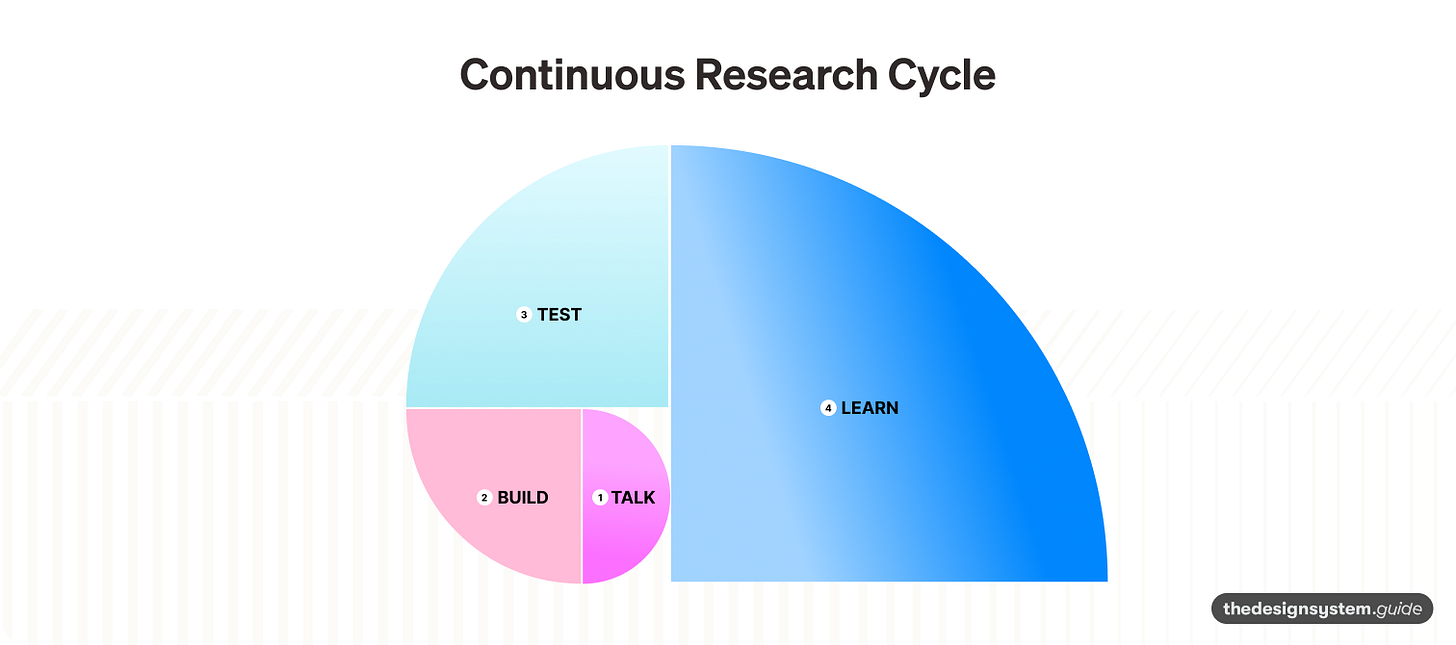Why research gets more important as AI gets faster
The continuous research cycle guide
👋 Get weekly insights, tools, and templates to help you build and scale design systems. More: Design Tokens Mastery Course / YouTube / My Linkedin
What you’ll learn:
Why AI speed makes research more critical, not less
How to run research in continuous cycles instead of one-time phases
The exact questions to ask designers, developers, and leadership about your design system
How to use AI to accelerate synthesis while never skipping user conversations
The pattern I’m seeing
Last week, I watched a senior product designer generate three complete UI mockups in under 20 minutes using AI. Beautiful layouts, on-brand colors.
None of them solved the actual user problem.
He’d skipped the research. Asked the AI to “design a dashboard for analytics users” without ever talking to an analytics user. The AI delivered exactly what he asked for, which was exactly the wrong thing.
This is the shift happening right now. As Sam Altman from OpenAI wrote:
But here’s the catch: Having ideas is easy. Building AI prototypes is easy. Everyone can do that now.
What’s hard? Building the right idea.
AI gives you speed. Research tells you which direction to sprint. 👇
Why research matters now more than ever (if you ask me)
We’re entering an era where anyone can generate interfaces, write code, and ship products faster than ever before. The barrier to building is collapsing.
But the barrier to building the right thing? That’s getting higher.
Think about it: When building something took months, you had natural checkpoints. Budget reviews. Sprint retrospectives. Long development cycles that forced you to validate before investing more time.
Now? You can build three different versions of your product before lunch. Which one do you choose?
Research is how you know.
But here’s the shift: Research isn’t something you do once upfront anymore. With AI-powered speed, you can run research in continuous cycles. Talk to users, build fast, test, learn, repeat. The tools have become faster, so your learning cycles should also become faster.
More cycles means more customer conversations, not fewer.
What research actually means (and doesn’t)
What I mean by “research skills”:
Research means:
Understanding the scenario your user is actually in
Knowing what success looks like from their perspective
Recognizing patterns across multiple user conversations
Identifying the difference between what users say and what they do
Testing assumptions before they become costly mistakes
Measuring task completion time and success rates
Observing actual behavior, not just collecting opinions
Testing functionality and core workflows
Research IS NOT:
Six-month ethnographic studies
Hiring a research team
Perfect methodology
Waiting for “enough” data before making decisions
Asking 5 people their color preferences and treating it as gospel
Letting subjective aesthetic opinions override usability data
Confusing “I don’t like it” with “I can’t use it”
Making decisions based on preference instead of performance
The “5 people don’t like orange” trap
Here’s a research anti-pattern I see constantly:
Your team has used blue as the primary brand color for 10 years. You introduce a new, vibrant orange. The research team interviews 5 people. Three people say, “I don’t like the orange.”
Now you think it is time to revert to blue.
This is not research. This is an opinion collection. 😌
A better way is to ask:
“Complete these three tasks using the new interface. How long did it take?”
“Can you find the primary action button on this screen?”
“Which version helps you complete your goal faster?”
The answers might be:
Task completion: 30% faster with orange (higher contrast, better visibility)
Button findability: 95% success rate vs 60% with blue
Goal completion: Same speed, but fewer errors with orange
Oh, and we all know that users don’t like change. That’s not data, that’s human nature.
What matters is: Can they use it? Does it work better? Do they complete tasks successfully? So, we need to understand what it is like to be our user. Not what we think it’s like. Not what the AI assumes it’s like. What it’s actually like.
I really liked the podcast episode on Lenny’s show about “dogfooding” your own product, where Sachin Kansal, Chief Product Officer at Uber, shares how he uses their own product and then shares the feedback with his team. This isn’t a formal research study. It’s how he uses the Uber app, noticing patterns, understanding the context. That’s research.
Another great example is Nikita Bier, CPO at X. He is constantly in conversation with users on X.
Now think about your story
Research isn’t just collecting data points. It’s understanding the human story behind every interaction. When a developer says, “The documentation is confusing,” there’s a story there. Maybe it’s 11 pm, they’re on deadline, and they can’t find the answer they need. That frustration is real. That context matters.
When you understand the story, you build with empathy. When you know the emotion, you design solutions that actually help.
And this skill doesn’t scale with AI. It can’t be automated. However, we can complete many tasks waaaaay faster due to the numerous AI tools available.
AI tools
The tools I use the most for research are:
Dovetail AI: unify feedback across GTM, CX, and Product
Claude: research, prototypes, analysis
Perplexity: deep research
Miro: has lots of helpful AI features
Riverside: recording interviews and getting transcriptions immediately
How AI amplifies research
1. Prompts
Give an AI a vague prompt, and it fills in the gaps with the most statistically likely answer based on its training data.
Your research defines the prompt. Without it, you’re designing for “the average user” who doesn’t exist.
2. Speed requires better judgment
When you could only build three iterations in a month, you had time to validate between each one. Now you can build three iterations before your first coffee break.
This speed is powerful if you know which direction to sprint. Catastrophic if you don’t.
3. Customization demands understanding
One of the most exciting aspects of AI is its ability to create customized experiences at scale. Personalized interfaces. Adaptive workflows. Context-specific features.
But personalization requires knowing:
What context actually matters to your users
What variations will be meaningful vs. annoying
When consistency matters more than customization
Again: Research tells you these things. AI executes them.
4. AI accelerates research
Here’s what AI does brilliantly:
Synthesize 50 interview transcripts in minutes instead of days
Identify patterns across hundreds of customer feedback tickets
Analyze usage data and surface anomalies
Generate research questions and discussion guides
Transcribe and tag qualitative data at scale
However, don’t expect AI to:
Notice the hesitation in someone’s voice when they say “it’s fine”
Watching the recorded interviews and observing the face, gestures
Ask the follow-up question that reveals the real problem
Build the trust that makes users share honest feedback
Catch the unexpected insight that wasn’t in your question list
Understand the context that numbers alone can’t capture
The research skills you need right now
1. Ask better questions
Stop asking: “What features do you want?”
Start asking: “Walk me through the last time you tried to [do the task].”
Stop asking: “Is this design good?”
Start asking: “What would you do next? Why?”
The quality of your insights is directly proportional to the quality of your questions.
2. Recognize patterns
Talk to five users, and you’ll see patterns. Talk to ten, and those patterns will be obvious. Talk to fifteen, and you’ll start seeing the exceptions that prove the rule.
You don’t need statistical significance. You need pattern recognition.
3. Test assumptions early
Your design system assumes designers will read documentation. Have you tested that?
Your component library assumes developers understand semantic HTML. Have you verified that?
Your design tokens assume teams understand how to implement and use them. Do they?
Every assumption is an opportunity to be wrong. 🫠
The continuous research cycle: not a funnel, a loop
Research is a practice. You do it continuously, in tight cycles. I see it in the form of a shell, constantly spiraling. You talk to users, build fast with AI, test, learn, and speak to users again. Each conversation informs the next iteration. Each build reveals new questions.
Why do design system teams also need research?
If you’re working on a design system, research skills aren’t optional; they’re your competitive advantage.
Why? Because design systems are:
Used by teams, not end users: You need to research how your actual users (designers and developers) work
Complex to implement: Small UX friction in your system gets multiplied across every team using it
Hard to measure: Without research, you’ll struggle to prove value or identify improvement areas
Questions you should be researching:
How do teams actually discover components in your library?
What stops developers from using your design tokens?
Where does documentation fall short?
What patterns keep appearing across multiple product teams?
I actually wrote a list of questions for you to go through. →
Some practical suggestions (if you are just starting):
Send the survey → evaluate the answers
Interview 3 designers, 3 developers; Observe how they use the design system (or UI kit in Figma)
Ask product teams what patterns they’re building outside the system
Test a new component with actual users before adding to the library
The bottom line
✅ AI tools are incredible force multipliers when pointed in the right direction
✅ Small research investments prevent large execution waste
✅ Research skills make you more valuable in an AI-powered world
The companies that win won’t be the ones who build fastest. They’ll be the ones who learn fastest.
Stay tuned for more and enjoy talking to your users, ⚡️
Romina
— If you enjoyed this post, please tap the Like button below 💛 This helps me see what you want to read. Thank you.
💎 Community Gems
✨ TokenForge (new Figma plugin for Figma Variables)
I had the opportunity to test and try the latest plugin for exporting variables. Lots of options, easy to use.
🔗 Link
Cursor Agents
You can now manage cloud agents from your Cursor editor, and access them from anywhere using a significantly improved cursor.com/agents.
🔗 Link









